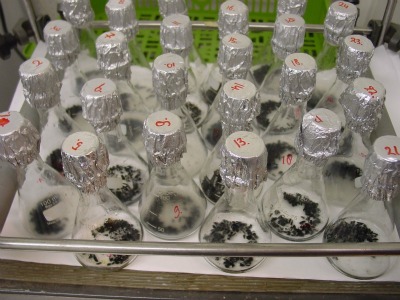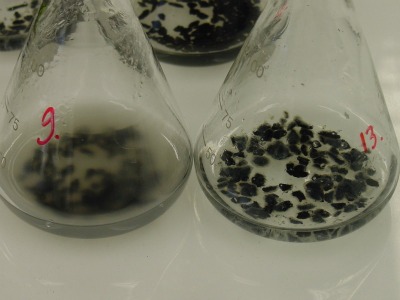
WEB EXCLUSIVE
Reusing phosphate from bone meal
Some bacteria can control
diseases such as Pythium and Fusarium organically. It has now been shown
that several of these bacteria can also dissolve phosphate from
carbonized bone meal.
Nov. 22, 2010, Wageningen, the Netherlands – Some bacteria can control diseases such as Pythium and Fusarium organically. It has now been shown that several of these bacteria can also dissolve phosphate from carbonized bone meal. The use of bone meal contributes to an improved organic disease control and the efficient reuse of phosphate in the food chain, and thus more sustainable agriculture production. These are some of the findings of research performed by Plant Research International, part of Wageningen UR and published in Applied Soil Ecology.

|
| Retorts with bone meal and bacteria. PHOTOS COURTESY WUR |
The finite nature of fossil phosphate sources makes the reuse of phosphate on a global scale highly relevant. Phosphate is essential to food production and because there is no replacement, efforts will have to be made to achieve the complete reuse of residual currents for the benefit of agriculture. Adding bone meal and antagonistic bacteria to the soil can therefore serve a dual purpose: the reuse of phosphate and the improvement of organic disease control.
Bone meal, a residual product from the meat processing industry, is heated to approximately 850°C (carbonization) to kill all pathogens. After being heated, the bone meal contains mainly phosphate and calcium. Due to its porous structure, the addition of bone meal to the soil protects antagonistic bacteria. It remained unknown until now, however, whether antagonistic bacteria were also able to dissolve phosphate. This would make the positive effects of the bacteria much larger as it would allow the crop to utilize the released phosphate and calcium from the bone meal.

|
| The solution in the left retort has become turbid due to the strong growth of the bacteria that dissolve phosphate from the bone meal. |
As part of the EU project PROTECTOR, scientists from Plant Research International tested around 100 antagonistic soil bacteria of various genera and from various soils. The bacteria were tested for their capability to dissolve phosphate from carbonized bone meal. Sixty per cent of the bacteria showed positive results. Twelve bacteria species were then tested for their growth and survival chances when using carbonized bone meal, and their potential for controlling pathogens. Four species of bacteria that were able to dissolve phosphate and suppress the damage of Pythium and/or Fusarium were eventually selected for further research in field and greenhouse tests.
This research is being carried out in co-operation with Terra Humana, a Hungarian company that develops environmentally friendly technologies. It studies the upscaling and commercialization possibilities of the carbonization process of bone meal, followed by the culturing of bacteria and fungi. The project also includes studies into the application possibilities of adding carbonized bone meal and antagonistic bacteria in greenhouse horticulture.
The article “Selection of phosphorus solubilizing bacteria with biocontrol potential for growth in phosphorus rich animal bone charcoal” has been published in Applied Soil Ecology.
Nora de Rijk is in the communication department of the Wageningen UR Plant Sciences Group.
Print this page